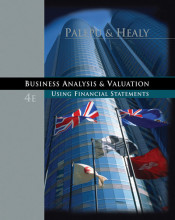Tekst Financial Analysis
34 important questions on Tekst Financial Analysis
What do ratio analysis assess?
What does cash flow analysis allow the analyst to examine?
What are the four levers managers can use to achieve their growth and profit targets?
- Higher grades + faster learning
- Never study anything twice
- 100% sure, 100% understanding
By which two factors is a company's ROE affected?
What does financial leverage indicates?
How can the Return of Assets (ROA) itself be decomposed as a product of two factors?
What does the profit margin (Return On Sales) indicates?
What are marketable securities?
What does Operating ROA measure?
What is the NOPAT margin a measure of?
What does the Operating asset turnover measure?
By which two factors is the gross margin influenced?
- price premium that a firm's products or services command in the
marketplace. The price premium is influenced by the degree of
competition and the extent to which its products are
unique.
- efficiency of the firm's procurement and production process.
Name expenses by nature of expense
What are the two primary areas of asset management?
- working capital management
- management of non current assets
What is the definition of operating working capital?
What does the operating working capital turnover indicates?
Trade payable turnover
Non-current assets generally consist of
The efficiency with which a firm uses its net non=current assets is measured by two ratios
Property, plant and equipment (PP&E) is the most important non-current asset in a firm's balance sheet. The efficiency with thick a firms PP&E is used is measured by
How do minority investments following the equity method impact net operating asset turnover?
How can financial leverage increases a firm's ROE?
Which ratios attempt to measure the firm's ability to repay its current liabilities?
When does a firm rely primarily on equity financing?
Net debt to net capital ratio
What does debt to equity ratio provide on explanation?
What is an indication of the degree of risk associated with its debt policy?
What does the coverage ratio tell a firm?
Analysts often use the concept of sustainable growth as a way to evaluate a firm's ratios in a comprehensive manner. A firm's sustainable growth rate is defined as?
What does the sustainable growth rate tell a firm?
In the reported cash flow statements firms classify their cash flows into three categories.
- cash flow from operations - cash generated by the firm from the sale of goods and services after paying for the cost of inputs and operations.
- cash flow related to investments - shows the cash paid for capital expenditures, inter corporate investments, acquisitions and cash received from the sales of non current assets.
- cash flow related to financing activities - cash raised from (or paid to) the firm's shareholders and debt holders.
Cash from operations an be calculated as follows
To compute the cash flow starting with a firm's net profit, an analyst adds back three types of items
- after-tax net interest expenses because this is a financing item that will be considered later
- non-operating gains or losses typically arising out of asset disposals or asset write-offs because these items are investment related and will be considered later
- non-current operating accruals such as depreciation and deferred taxes because these are non cash operating charges
In interpreting firms' cash flow from operations after working capital, it is important to keep in mind
The question on the page originate from the summary of the following study material:
- A unique study and practice tool
- Never study anything twice again
- Get the grades you hope for
- 100% sure, 100% understanding
































